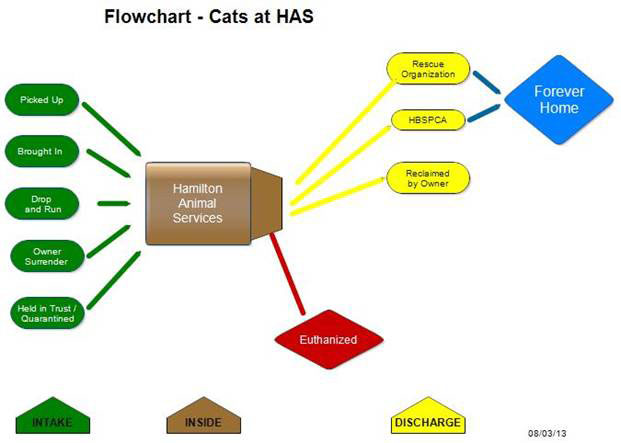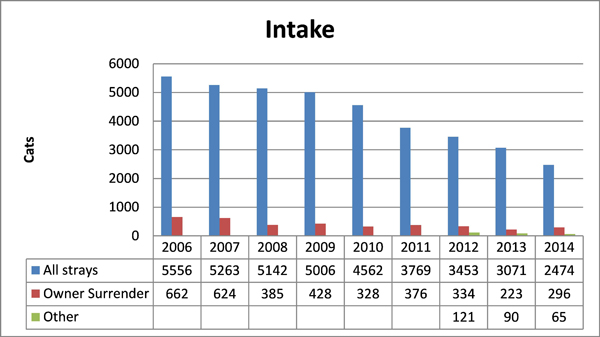
(See 2015 Final Report)
As for how it was in 2012 ...
HAS: What Happens to the Cats
When, in 2011, the name was changed from Hamilton Animal Control (HAC) to Hamilton Animal Services (HAS), it was as part of an effort to re-brand. Some of those who’ve noticed the name change are curious and wonder what it signals while others snicker and voice angry comments such as “What services do they provide other than killing cats?”
HAS wants a better public image and it claims to be committed to an effort to help all animals brought in (including the cats) and to be making changes that will increase the odds of their getting out alive.
There’s a lot of skepticism about these claims.
To address that skepticism – and look into the specific concerns and criticisms - it’s necessary to have an idea of what actually happens to the cats at HAS - how they come to be there (Intake), how they're cared for (Inside), and how some get out alive (Discharge) and others don't (Euthanized).


Intake in 2014 was significantly down (by 540) from 2013, showing that the downward trend that started in 2010 had continued through a 5th year. This decrease, primarily of "Strays", is likely attributable to limitation on the pickup service that started in Jamuary 2011. If one looks back to 2006, when the Total Intake # was 6,218, and compares that with the 2014 Total Intake of 2,853, the difference is 3,383 cats,
To get a clear picture of what's happening:
First one needs to realize that cats arrive at HAS in one of five ways:
Picked Up. Prior to 2011, HAS had responded 24/7 to all public pick-up requests by dispatching a vehicle to the address and bringing in the cat if it was confined, caged or willing to enter a cage. In January of that year, HAS reduced this service by restricting it to regular business hours only. In 2013, it further restricted the hours to mornings only and also began to dispatch vehicles only under special circumstances as determined on a case-by-case basis. (It has continued, and will continue to, respond 24/7 to emergency calls to pick up sick/injured cats.)
Brought In. HAS is obliged to accept, during business hours, strays brought to the door in a cage, box or container of any sort and is authorized to restrict intake only during periods of extreme overcrowding.
Dumped. HAS often ends up taking in cats that are left at the door or in the vicinity of the building in cages, boxes, and all sorts of containers - even Tupperware - at any time of the day and night, on weekdays and holidays.
Owner Surrendered. HAS accepts, for a fee, cats surrendered by owners who want their cats to find new homes or make the request that their cats be euthanized. HAS stresses that surrendering to HAS should be viewed as a last resort and informs owners who want their cat to get a new home that there is no guarantee that surrendered animals will get the chance to be adopted. The # in this category, while fuctuating slightly year-to-year, remains at a low level.
Other. HAS responds to requests from Emergency Services (Police, Fire, Ambulance), to take in the pets of owners who are arrested, have house fires, are taken to hospital or found deceased. It then holds them in trust (for a time) until the owner (or someone designated by the owner) picks them up. The # in this category is also very small.
Certainly, some of the people who request a pick-up, or drop a cat off, do so because they consider cats to be a nuisance or disposable. However, most want to help some homeless cat or a pet they can no longer care for.
Secondly, one needs to examine how many cats arrive at HAS and llook into reasons for th edecline.
If one looks back to 2006, when the Intake was at 6,218 cats, one gets an idea of what it means to be a "high volume" shelter and of how high the HAS Intake #s used to be.

The chart above illustrates the dramatic decrease. At first the decline was slow and unclear until, in 2010, a consistently downward trend (as pictured in the chart), started to emerge.
In 2014, the Intake was down to 2,835. This was 540 fewer cats than the 2013 Intake # of 3,071 and it demonstrated that this downward trend had continued through 5th consecutive year.
Looking back at the stats for each these 5 years, one can see that the year-to-year decline is in the intake of Strays (ie. In the # of cats picked up, brought in, or dumped as “strays.”)
This is by far the largest category of cats and it suggests that this downward trend is attributable to the changes in pick-up policy that began in 2011, and to an increasing tendency for HAS, during times of serious overcrowding, to put a "CLOSED" sign on their door. Several News Alerts in July and November, 2014, made reference to these closures, explaining why they were happening and describing the effort made, during those times, by HBSPCA and Rescue Groups to make space for new arrivals by quickly transferring as many cats and kittens as possible out of HAS cages and into their care.
Thirdly, one needs to ask why reducing intake matters.
The short answer is that there is a direct connection between Intake and Euthanized - the fewer the # of cats inside, the fewer the # of cats that end up being euthanized. A 2007 consultant’s report, commissioned by the City, followed that logic and suggested that the mandated pickup of strays be discontinued. At that time cities to which Hamilton was and continues to be unfavorably compared were already moving in the direction of discontinuing pickup. The aim was to eliminate the need to euthanize any cat for space and to divert funds freed up due to the lowered pickup costs and the lowered vet costs specific to euthanizing, toward efforts to improve conditions (and care) inside shelters and to needed services such as affordable spay/neuter. Because Hamilton did not begin to act immediately on that 2007 suggestion, it has taken until 2014 for the city to “catch up” and become part of an Ontario (and North America) wide effort to humanely address cat overpopulation .For More about other municipalities
On to "An inside look at HAS" >>>

As of January 2015, updated statistics willl be posted monthly (instead of weekly). See the ticker-tape at the bottom of the Home page for 2015 monthly and YTD counts.
